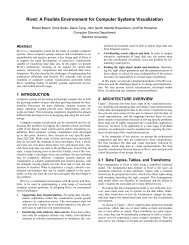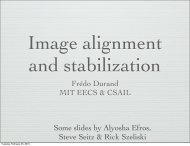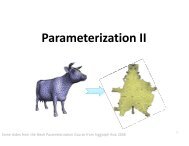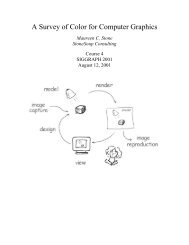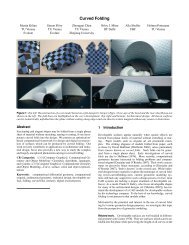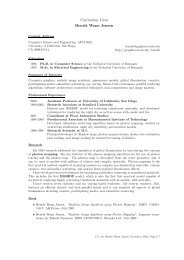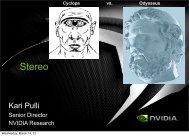Rotation and Phase of the Moon The Moon’s geometry is modeled in a fixed lunar coordinate system. To orient the Moon in ecliptic coordinates, rotate by the matrix Rz(f + π)Rx(0.026920)Rz(l ′ − f), with f as above. Then rotate by the equatorial to horizon conversion matrix for the orientation in horizon coordinates. Translating by the Moon’s position in rectangular horizon coordinates (scaled by 6378137m) completes the position and orientation of the Moon in local horizon coordinates. Using rectangular coordinates makes it easy to compute the position of the shadow terminator. If �m is the topocentric position of the Moon, and �s is that of the sun (in Earth radii: multiply dMoon above by 23455; there is no need to correct for parallax for the sun’s position) then the vector (�s − �m) × (�s × �m) points from the center of the Moon to the leading (light to dark) terminator. Temperature to Luv Conversion Temp. (K) u v Temp. (K) u v 100 000 0.18065 0.26589 4000 0.22507 0.33436 50000 0.18132 0.26845 3636 0.23243 0.33901 33333 0.18208 0.27118 3333 0.24005 0.34305 25000 0.18293 0.27407 3077 0.24787 0.34653 20000 0.18388 0.27708 2857 0.25585 0.34948 16667 0.18494 0.28020 2667 0.26394 0.35198 14286 0.18611 0.28340 2500 0.27210 0.35405 12500 0.18739 0.28666 2353 0.28032 0.35575 11111 0.18879 0.28995 2222 0.28854 0.35713 10000 0.19031 0.29325 2105 0.29676 0;35822 8000 0.19461 0.30139 2000 0.30496 0.35906 6667 0.19960 0.30918 1905 0.31310 0.35968 5714 0.20523 0.31645 1818 0.32119 0.36011 5000 0.21140 0.32309 1739 0.32920 0.36038 4444 0.21804 0.32906 1667 0.33713 0.36051 References [1] BARANOSKI, G., ROKNE, J., SHIRLEY, P., TRONDSEN, T., AND BASTOS, R. Simulating the aurora borealis. In Proc. of Pacific <strong>Graphics</strong> (2000). [2] BLACKWELL, D. E. The zodiacal light. Scientific American 54 (July 1960). [3] BLINN, J. The jupiter and saturn fly-by animations, 1980. [4] BLINN, J. F. Light reflection functions for simulation of clouds and dusty surfaces. Proc. of SIGGRAPH (1982). [5] DERMOTT, S. F., AND LIOU, J. C. Detection of asteroidal dust particles from known families in near-earth orbits. In AIP Conference Proceedings (July 1994), vol. 301(1), pp. 13–21. [6] DOBASHI, Y., NISHITA, T., KANEDA, K., AND YAMASHITA, H. A fast display method of sky colour using basis functions. J. of Visualization and <strong>Computer</strong> Animation 8, 3 (Apr. – June 1997), 115–127. [7] DUFFETT-SMITH, P. Astronomy with your personal computer, 2nd ed. Cambridge University Press, 1990. [8] DURAND, F., AND DORSEY, J. Interactive tone mapping. Eurographics Workshop on Rendering (2000). [9] EBERT, D., MUSGRAVE, K., PEACHEY, D., PERLIN, K., AND WORLEY, S. Texturing and <strong>Model</strong>ing: A procedural Approach. Academic Press, 1994. [10] GREEN, R., Ed. Spherical Astronomy. Cambridge Univ. Pr., 1985. [11] HAPKE, B. Optical properties of the lunar surface. In Physics and astronomy of the Moon, Kopal, Ed. Academic Press, 1971. [12] HAPKE, B. W. A theoretical photometric function of the lunar surface. Journal of Geophysical Research 68, 15 (1963), 4571–4586. [13] HENYEY, L. G., AND GREENSTEIN, J. L. Diffuse radiation in the galaxy. Astrophysics Journal 93 (1941), 70–83. [14] HOFFLEIT, D., AND WARREN, W. The Bright Star Catalogue, 5th ed. Yale University Observatory, 1991. [15] HUNT. Light and dark adaptation and the perception of color. Journal of the Optical Society of Am. A 42, 3 (1952), 190. [16] J. VAN DIGGELEN. Photometric properties of lunar carter floors. Rech. Obs. Utrecht 14 (1959), 1–114. [17] JENSEN, H. W., PREMOZE, S., SHIRLEY, P., THOMPSON, W., FERWERDA, J., AND STARK, M. <strong>Night</strong> rendering. Tech. Rep. UUCS-00-016, <strong>Computer</strong> Science Dept., University of Utah, Aug. 2000. To appear in the SIGGRAPH conference proceedings 8 [18] JOHNSON, H. L., AND MORGAN, W. W. Fundamental stellar photometry for standards of spectral type on the revised system of the yerkes spectral atlas. Astrophysics Journal 117, 313 (1953). [19] KLASSEN, R. <strong>Model</strong>ing the effect of the atmosphere on light. ACM Trans. on <strong>Graphics</strong> 6, 3 (1987), 215–237. [20] KOPAL, Z. The Moon. D. Reidel Publishing Company, Dordrecht, Holland, 1969. [21] LANG, K. Astrophysical formulae. Astronomy and astrophysics library (1999). [22] LARSON, G. W., RUSHMEIER, H., AND PIATKO, C. A visibility matching tone reproduction operator for high dynamic range scenes. IEEE Trans. on Visualization and <strong>Computer</strong> <strong>Graphics</strong> 3, 4 (Oc. - Dec. 1997), 291–306. [23] MEEUS, J. Astronomical Formulae for Calculators, 4th ed. Willman-Bell, Inc., 1988. [24] MEEUS, J. Astronomical Algorithms, 2nd ed. Willmann-Bell, Inc., Richmond, VA, 1999. [25] MELLINGER, A. A 360 ◦ x180 ◦ all-sky panorama. http://canopus.physik.unipotsdam.de/˜axm/images.html, 2000. [26] MINNAERT, M. Light and Color in the Outdoors. Springer-Verlag, 1974. [27] NAVAL RESEARCH LABORATORY. Clementine deep space program science experiment. http://www.nrl.navy.mil/clementine/. [28] NAVARRO, R., AND LOSADA, M. A. Shape of stars and optical quality of the human eye. Journal of the Optical Society of America (A) 14, 2 (1997), 353–359. [29] NISHITA, T., DOBASHI, Y., KANEDA, K., AND YAMASHITA, H. Display method of the sky color taking into account multiple scattering. In Proc. of Pacific <strong>Graphics</strong> (1996). [30] NISHITA, T., AND NAKAMAE, E. Continuous tone representation of threedimensional objects illuminated by sky light. In <strong>Computer</strong> <strong>Graphics</strong> (SIG- GRAPH ’86 Proceedings) (1986), vol. 20(4). [31] NISHITA, T., SIRAI, T., TADAMURA, K., AND NAKAMAE, E. Display of the earth taking into account atmospheric scattering. In <strong>Computer</strong> <strong>Graphics</strong> (SIG- GRAPH ’93 Proceedings) (1993), vol. 27. [32] OBERSCHELP, W., AND HORNUG, A. Visualization of eclipses and planetary conjunction events. the interplay between model coherence, scaling and animation. In Proc. of <strong>Computer</strong> <strong>Graphics</strong> International (2000). [33] OLSON, T. The colors of the stars. In IST/SID 6th Color Imaging Conf. (1998). [34] PREETHAM, A. J., SHIRLEY, P., AND SMITS, B. A practical analytic model for daylight. In Proc. of SIGGRAPH (1999). [35] PREMOZE, S., THOMPSON, W., AND SHIRLEY, P. Geospecific rendering of alpine terrain. In Eurographics Workshop on Rendering (1999). [36] REACH, W. T., FRANZ, B. A., KELSALL, T., AND WEILAND, J. L. Dirbe observations of the zodiacal light. In AIP Conference Proceedings (January 1996), vol. 348, pp. 37–46. [37] RICHTER, N. B. The photometric properties of interplanetary matter. Quarterly Journal of the Royal Astronomical Society 3 (1962), 179–186. [38] ROACH, F., AND GORDON, J. The Light of the <strong>Night</strong> <strong>Sky</strong>. Geophysics and Astrophysics Monographs, V. 4. D Reidel Pub Co, 1973. [39] SIEGEL, R., AND HOWELL, J. R. Thermal Radiation Heat Transfer, 3rd ed. Hemisphere Publishing Corporation, 1992. [40] SMITH, R. C. Observational Astrophysics. Cambridge University Press, 1995. [41] SPENCER, S., SHIRLEY, P., ZIMMERMAN, K., AND GREENBERG, D. <strong>Physically</strong>-based glare effects for digital images. In <strong>Computer</strong> <strong>Graphics</strong> (Proc. Siggraph) (1995). [42] TADAMURA, K., NAKAMAE, E., KANEDA, K., BABA, M., YAMASHITA, H., AND NISHITA, T. <strong>Model</strong>ing of skylight and rendering of outdoor scenes. In Eurographics ’93 (1993), Blackwell Publishers. [43] UPSTILL, S. The Realistic Presentation of Synthetic Images: Image Processing in <strong>Computer</strong> <strong>Graphics</strong>. PhD thesis, Berkeley, 1985. [44] U.S. NAVAL OBSERVATORY, R. G. O. The Astronomical Almanac for the Year 2001. U.S. Government Printing Office, 2001. [45] VAN DE HULST, H. Light Scattering by Small Particles. Wiley & Sons, 1957. [46] VAN DE HULST, H. Multiple Light Scattering. Academic Press, 1980. [47] YAEGER, L., UPSON, C., AND MYERS, R. Combining physical and visual simulation – creation of the planet jupiter for the film ”2010”. Proc. of SIGGRAPH) (1986).
Figure 7: The Moon rendered at different times of the month and day and under different weather conditions. Clockwise from top left. The sliver moon is a simulation of the moon on Dec. 5; Earthshine makes all of the moon visible. The Quarter Moon (Dec. 12) is a day simulation and the moon is seen behind the blue sky. The Gibbous Moon (Dec. 17) is a rendering of the moon low in the sky; it is colored red/orange due to attenuation in the atmosphere of the blue part of the light. The full moon (Dec. 22) is a simulation of the moon seen through a thin layer of clouds with strong forward scattering; the scattering in the cloud causes the bright region around the moon. Figure 8: Zodiacal light seen as a wedge of light rising from the horizon in an early autumn morning. Zodiacal light is easiest to see on spring evenings and autumn mornings from the Northern hemisphere. To appear in the SIGGRAPH conference proceedings 9 Figure 9: Close-up of rendered stars. Note the glare simulation around the brighter stars. The Big Dipper (in the constellation of Ursa Major) is clearly recognizable at the top of the image. Figure 10: Time-lapse rendering of stars. A simulation of a 30minute camera exposure of the sky. Note how the stars move in circular curves due to the rotation of the earth. Also, note the color of the stars (we did not apply tone-mapping for a human observer, and the true colors of the stars are seen in the trails).




